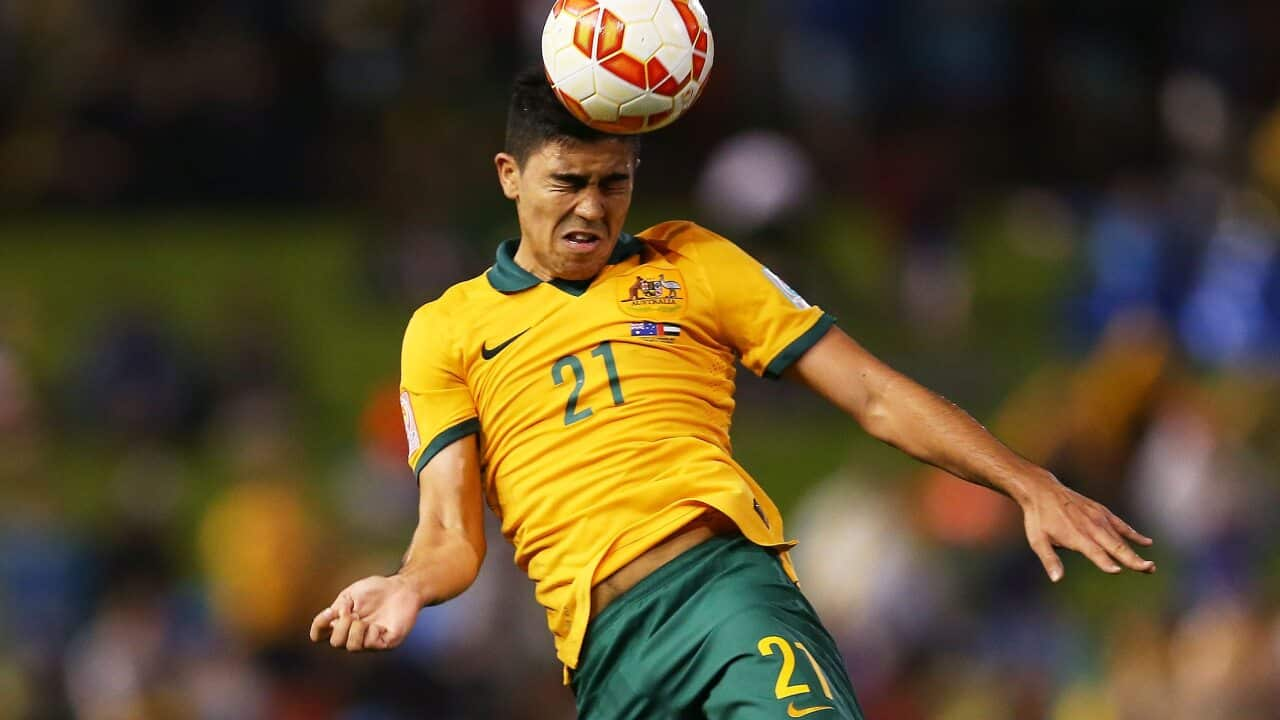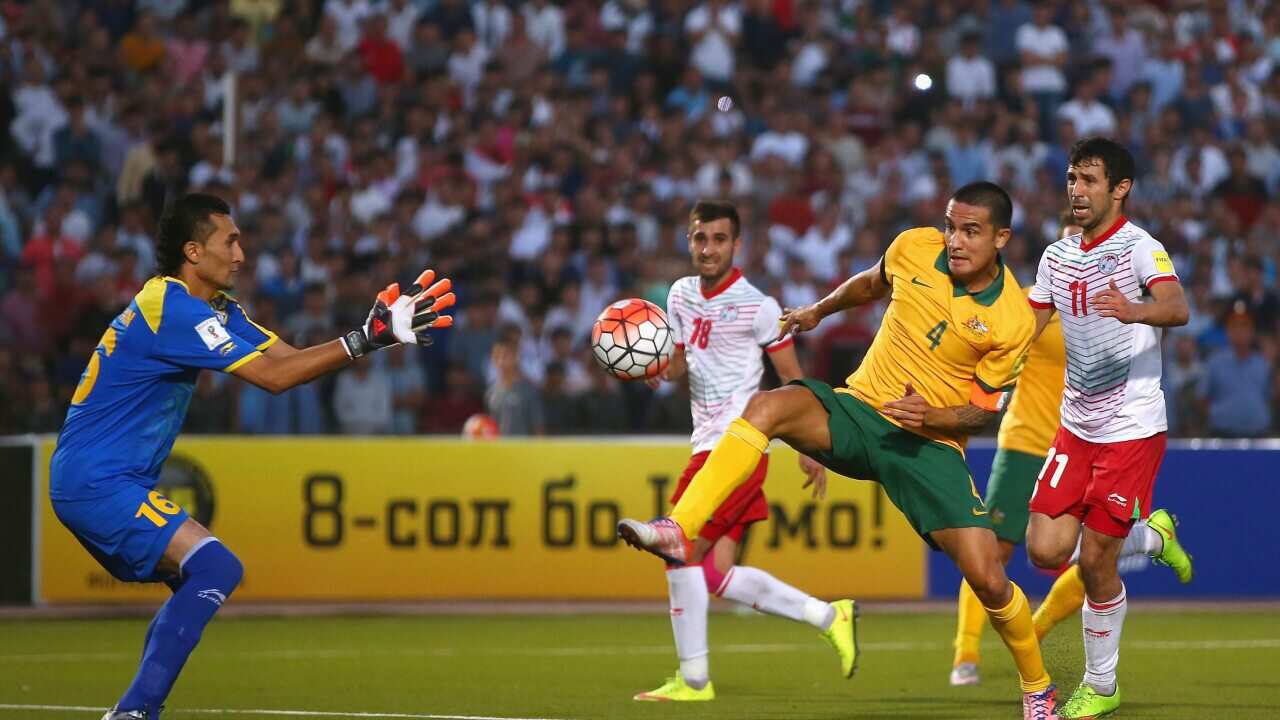The 5-0 win against Bangladesh in Perth, and the 3-0 win against Tajikistan in Dushanbe were both as simple as the scoreline suggested.
However, the challenge for Ange Postecoglou and his coaching staff is to learn from the 180 minutes of football, which came nearly three months after the first FIFA World Cup qualifier against a nervy 2-1 win in Bishkek.
Diamonds are forever
Postecoglou eschewed his favoured 4-3-3 formation for a 4-4-2 formation with a midfield diamond, for both games.
It was a clever way to fit in his two "number 10s", Aaron Mooy and Tom Rogic for the first game, and to push Massimo Luongo further forward in the second.
It was also an opportunity to play two genuine forwards, in the hunt for goals against defensively minded opposition.
The key to the diamond midfield is the contribution in attack of the full-backs, and Jason Davidson raided down the left with aplomb, while Tarek Elrich and Ryan McGowan both played their parts in goals from the right flank.
While Mathew Leckie and Nathan Burns can both play through the middle next to Tim Cahill, it looks like Robbie Kruse and Tommy Oar could be the biggest losers in the shape shift.
The beginning of the end for Jedinak?
Postecoglou's willingness to change the side's shape and balance in Mile Jedinak's absence is telling.
The emergence of Mooy and Rogic as creative lynchpins, on the back of Luongo's rise to one of the first names on the team sheet, means Postecoglou has a decision to make at the base of midfield.
Milligan is a senior player now and his performances beg the question whether there is necessarily room, or a need for both he and Jedinak, when Postecoglou can turn to more creative, imaginative players instead.
Jedinak is the captain of course, but he is at Crystal Palace too, and that hasn't stopped manager Alan Pardew turning to other options.
Throw in the emergence of Rostyn Griffiths as a regular first team player at Eredivisie side Roda JC, and the call ups for Jackson Irvine and Luke Brattan to the recent squad.
Even if Postecoglou does choose two anchors, Jedinak has a real fight on his hands.
Spoilt for playmaking choice
By making a decision on picking either Milligan or Jedinak as the midfield's anchor, and shifting to a midfield diamond, Postecoglou has potentially conjured up the perfect storm.
Picking Milligan/Jedinak, and Luongo, leaves two places in midfield that could be occupied by the two creative fulcrums, Mooy and Rogic.
If Postecoglou chooses to shore things up by playing two anchors plus Luongo, or Matt McKay as a runner alongside one anchor and Luongo, it still leaves room for a genuine playmaker in the starting XI.
Mooy has settled quickly at international level and has shown he can influence games as he does for his club, Melbourne City.
Rogic, meanwhile, has always had the ability, and now he has fitness and regular football too. It is only a matter of time before this prodigiously gifted talent cements himself in the starting line-up.
The only question is, who misses out?
Wright place, right time
Matthew Spiranovic and Trent Sainsbury are Australia's first choice central defenders and the AFC Asian Cup winning partnership, but Preston North End's Bailey Wright may have just leapt the queue that had formed behind them.
Alex Wilkinson played each game at the FIFA World Cup in Brazil, and stepped in when Spiranovic was suspended for the AFC Asian Cup quarter final against China.
Yet with Sainsbury missing through injury for September's qualifiers, it was Wright, not Wilkinson, who Postecoglou turned to as Spiranovic's partner.
Wilkinson is a top character and a solid footballer, who has grown into the national team set-up after receiving his opportunity relatively late in the day. He even wore the captain's armband in the second half of the international against Macedonia earlier this year.
But he is 31, and Wright is 23. With Tomislav Mrcela also waiting in the wings, Postecoglou might just be thinking about planning for future.
It would be a risk though to discard Mr Reliable, especially with bigger fish to fry down the track.
Cahill is still king
The Shanghai Shenhua striker is in a rich vein of form in China, and it translated to the green and gold, when he scored a double against Tajikistan.
He was left on the bench against Bangladesh as Postecoglou, rightly, saved him for the sterner test in Dushanbe, and as so often before, the talisman delivered.
Cahill now has 41 goals in 85 games for the Socceroos, and although Leckie, Burns, Tomi Juric, and Adam Taggart will be in the mix down the track, Cahill is as close to a sure thing as Postecoglou will allow.
At 35 years of age, Cahill is still the Australian goalscoring king, and more important than he was at 26, when he was Guus Hiddink's joker in the pack at the 2006 FIFA World Cup in Germany.











